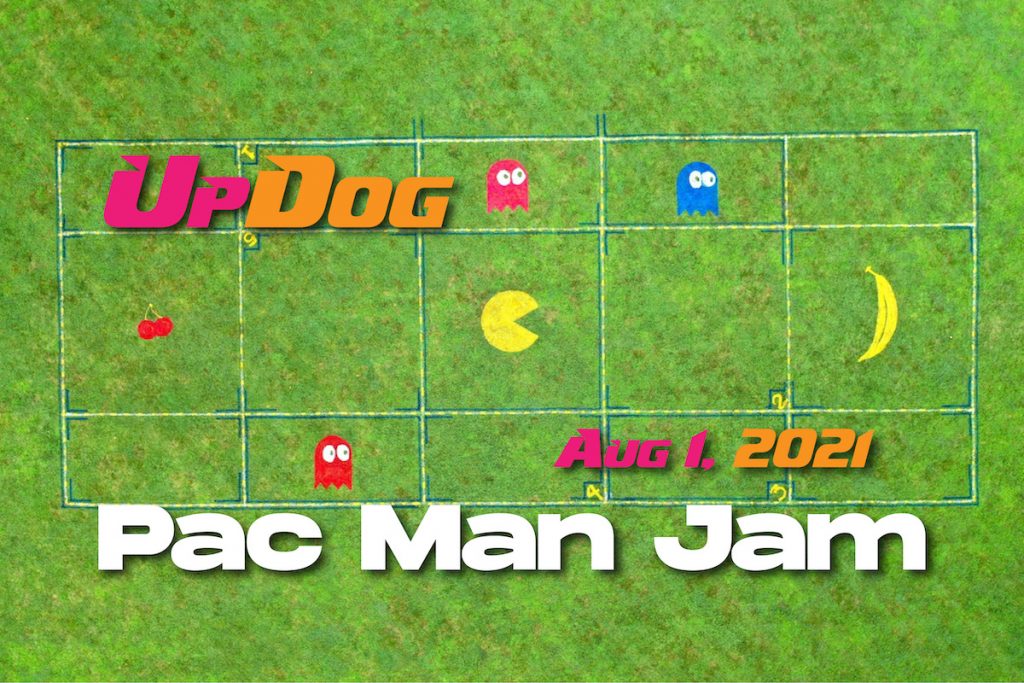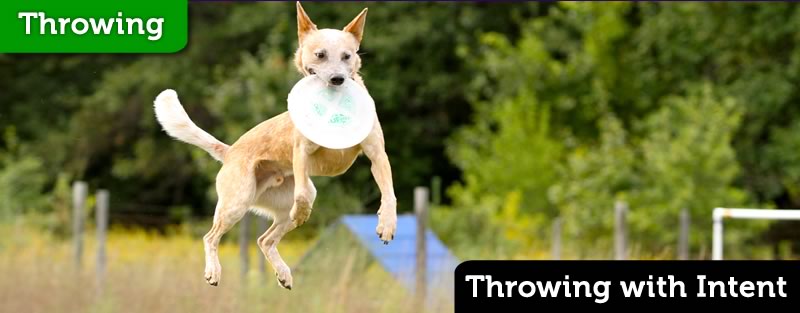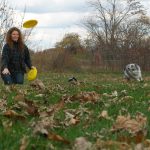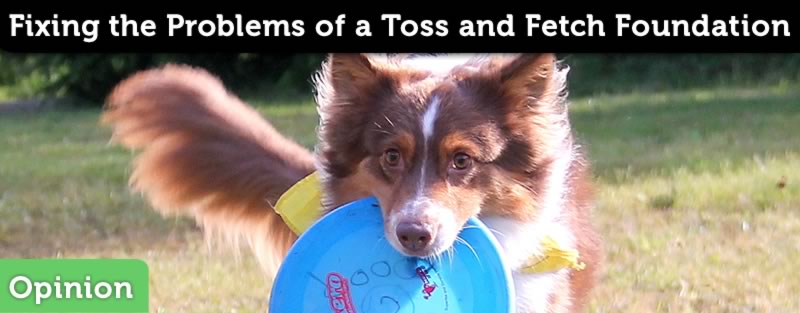
Fixing the Problems of a Toss and Fetch Foundation

Toss and Fetch, Single Disc, Mini-Distance, Throw and Catch, whatever you want to call it, the timed distance game with 1 disc, while an interesting event, is no way to start players off in the sport of canine disc.
We do a lot of teaching and are constantly trying to fix things that the unhealthy focus on toss and fetch has created for noobie teams. The problems created are legion:
- Slow retrieve
- 40 yards or nothing
- Frazzled nervous handlers
- Refusal to drop
- Refusal to get close to the handler
- Inability to switch targets
- Lack of desire to work close
- Ground Bound Hounds
- Shutting Down
Most of these problems can be traced back to toss and fetch being the first competitive disc dog endeavor that people enter into in the disc dog world. If the handler’s don’t have a good bit of confidence, they can be stuck in toss and fetch for two or three years.
This allows the problems outlined above to fester and grow, sometimes killing the desire to play freestyle completely. These problems are frustrating – fixing one, breaks another, “I CAN’T fix it!”
How Many Have Not Come Back
I’ve seen the look on people’s faces when they talk about these problems, and I feel for them. It’s not cool to get bogged down with a foundational freestyle skill, a simple elemental skill, like going after another disc, or retrieving it to the handler. “If I can’t do these simple things, we might as well not play!”
It’s a shame. Who knows how many great teams have dropped out of the game because of these frustrations. Shut down before they even learned how to play.
I think the disc dog community should change the novice and entry level formats to something that actually grooms future freestylers by setting them up for success. Let’s take a closer look at the problems that a toss and fetch foundation creates for teams and try to come up with some solutions that could help teams develop faster and more effectively.
What’s the Problem With a Single Disc Frisbee Dog Foundation?
Single Target and Ticking Clock
The problems with a mini-distance foundation that there is only 1 target, it’s narrowly focused, and it’s a timed event.
Having only one target is not a problem for many teams, but for the noobie with little experience and training skills, one target can be a huge problem especially when you add on the ticking of the clock. There are hundreds of teams who have serious problems with their game because of the cumulative effects of a single disc and a ticking clock. The ticking clock makes the handler act crazy and the single disc gives the dog too much control over the game. It’s a bad combination.
Toss and Fetch is a Test, Not a Lesson
If there is any problem with the dog to handler disc exchange, the dog almost always feels it. The handler puts on pressure and the dog starts to avoid the pressure. The more the dog avoids the pressure, the more pressure the handler piles on. And don’t forget the ticking clock… tick tock!
Pretty soon you have a handler tearing his or her hair out and a dog that wants nothing to do with this game. Scores suffer, the dog and handler relationship suffer, the love of the game suffers, and the fun is quickly removed from the contest.
Is this an exaggeration? Perhaps, but you don’t have to sit through too many handlers in any toss and fetch contest to see it live and in person. I’ve seen it hundreds of times, and I don’t watch a lot of toss and fetch.
Pattern Training, Reward Placement and Pressure
Reward PlacementThe dog puts his face where the Cookie or the disc happens. Where you put the reward matters. Reward Placement is huge in disc dog freestyle. Your dog’s face will always wind up... More is a problem with a toss and fetch foundation. We wind up pattern training our dogs with the reward 40 yards away. Go around, run 40 yards, come back and give me the disc.
If I had a nickel for every time I’ve heard, “He just doesn’t like to play close to me!”
Well, with a constant dose of 40 yards of freedom added to the pressure of a dog/handler disc exchange as the clock ticks, should we be surprised?
“Nothing good ever happens close to my handler. Every time I get there, I have to drop my Disc… And she acts so crazy!”
This is proven, over and over in toss and fetch rounds. Lips are pushed onto teeth, the scruff or collar is grabbed, the handler yells, stomps forward like some kind of Frankenstein trying to make their dog drop the single target. Once again, if you think it’s an exaggeration, just watch a whole day of toss and fetch. You’ll see it and various other degrees of uncomfortable.
Between the pattern train of Go round and catch at 40 yards of freedom, giving up a disc and sometimes hanging out with Frankenstein, it’s a no brainer. Many dogs will be reluctant to play close to the handler.
Ground Bound Hounds
Another problem that stems from a toss and fetch foundation is that the dogs never really learn to leap well. They just run out, chase down discs that are chucked 40 yards, and either fling themselves wildly at the disc or wait for it to come down to the ground.
It’s extremely hard to toss a well timed and well placed disc at 40+ yards. It’s nearly impossible for a noobie. How many unbelievable leapers have been ruined by a couple years of toss and fetch?
What needs to happen in order to help a dog learn to leap is for disc placement to be consistently well timed and well placed. Watch a day of toss and fetch and see how consistent and well placed throws are.
A toss and fetch foundation is not helpful for teaching the dog quality leaping or the handler quality placement. Handlers should be learning to hook up with their dogs, and deliver strikes to them as they move across the field.
But Wait, There’s More…
There are other problems with a toss and fetch foundation. I’ll be happy to take them up in comments, or in a discussion thread, but I’d like to move on to solutions. If you want, go grab a beverage or do something else for a moment. Let everything sink in. This is a long post!
Building a Stronger Freestyle Disc Dog Foundation
There are many ways we can build a stronger disc dog foundation, but I think that there are 2 keys to helping teams get started with a strong foundation that will enable them to be competent and confident handlers and have a better relationship with their dogs. The 2 key elements are, ironically, incompatible with the 2 problems with a toss and fetch foundation: the ticking clock and the single target.
There’s No Time in Dog Training
The clock needs to be removed from the equation. Removing the clock would take lots of pressure off the dog and handler transfer, which would in turn remove most of the yelling, collar grabbing, scruff pulling and lip pinching.
It would place the emphasis on the task at hand: throwing and fetching.
The dog and handler relationship, the love of the game, and fun would be enhanced greatly by removing the ticking clock from the foundation of canine disc.
Two Targets Are Better Than One
Adding an additional target would allow handlers to train their dogs in contests.
While this is not a huge deal for established or elite players, for the noobie, it is a serious problem. The established player has trained. They train outside of contests.
But for the noobie, just walking up on a contest, one target could kill the game for them. Running around chasing your dog trying to snatch the disc from his mouth in front of a bunch of cool discdoggers and fans can be a traumatic experience.
You ever wonder how many potential future world class competitors were too embarrassed to play in public after a 1 catch and a 45 second chase of a non-retrieving dog debacle?
Having 2 targets gives the handler a fair shake in the game. After the catch, all the dog has a dead toy, but the handler has a live one. Having the additional power of a live toy gives the handler a little more power to control the game. With one target, the dog literally has all the marbles and can make his handler do whatever he wants.
Perfect Practice Makes Perfect
If the field were shortened a bit, say to 20-25 yards, there would be much more opportunity to deliver consistent well placed and timed throws.
For the noobie, this would give them an achievable max target, and for the established and elite players, an accuracy zone would give them a serious challenge that would also fit within the scope of their Freestyle game.
One of the objects of this game is to make the dog look good. Setting up a 15 yard BIG leap on the run makes the dog look great. Throwing a disc that our dog needs to stop and wait for as it floats down doesn’t make them look so hot.
Placing some focus on distances where precision of timing and placement are important would help noobs, established, and elite players develop the disc placement skills to make their dogs look their best.
The Past Holds the Answer
I remember talking to Alex Stein while we were hanging out in Stowe. We were at the bar talking about old schoold disc dogging, and Alex told us that the toss and fetch field used to be circular. Apryl and I thought that was really thought that was cool, which brings us to a possible solution to the problem of a toss and fetch foundation.
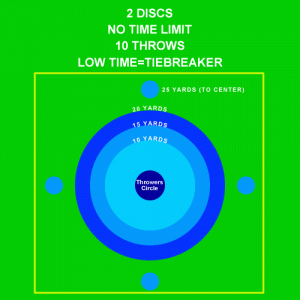
The game doesn’t have a name yet, it doesn’t have point values assigned, it’s simply a concept at this point in time. The concept is designed to be user friendly for noobies, to be challenging for established and elite players, and to create a solid freestyle foundation for all.
There are similar games, Skyhoundz Bullseye comes to mind from an appearance perspective, but the small scale and the fact that it’s a timed event first makes it an entirely different game.
As you can see from the picture of the field layout, there are 2 discs, no time limit, 10 throws, bonus circles, and a tie breaker for the low time.
This means that pretty much all things necessary for an objective game are there but it’s designed to give people the skills they need to play a good game of disc with their dogs and to prepare them for Freestyle.
Dogs could be comfortable with multiple discs from their first contest. No more problems getting dogs to switch to multiple discs.
Handlers would not have the ticking of the clock pressuring them to pressure their dogs for a retrieve. A retrieve would be easier to teach, less stressful and more successful for the team’s entire career.
Conclusion
A game like this is not intended to replace toss and fetch as a contest. It is intended to replace toss and fetch as the foundation of the game of canine disc.
The field would be easy to lay out, requiring only a center point, some rope and some field marking paint.
I really believe that people who don’t want to learn to play freestyle are really intimidated by all the training that must be done with their dog to get them to perform all the skills necessary for a freestyle routine given their problems with toss and fetch.
This circular game, without the ticking clock and with the shorter field and multiple targets, would have them playing something very close to freestyle right from the get go. I think that would be a much better foundation for new players than the current game of toss and fetch.
What do you think?





